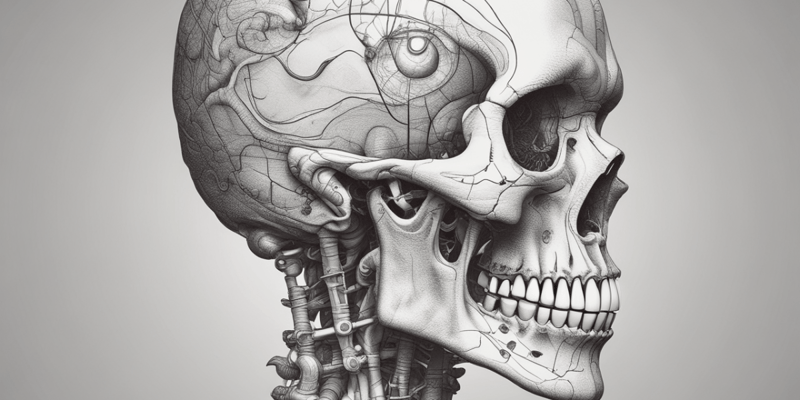Questions and Answers
What is the term for the area where the femur articulates proximally?
Which bone articulates with the scapula at the glenoid cavity?
Which structure is considered part of the ischium?
What is the primary function of the coracoid process found on the scapula?
Signup and view all the answers
What is the primary function of the patella?
Signup and view all the answers
What distinguishes the female pelvic brim compared to the male pelvic brim?
Signup and view all the answers
Which of the following statements accurately describes the ulna?
Signup and view all the answers
What characterizes the pelvic girdle's composition?
Signup and view all the answers
Which bone is considered the longest and heaviest in the human body?
Signup and view all the answers
Which feature is not present on the scapula?
Signup and view all the answers
Which statement about the tibia and fibula is correct?
Signup and view all the answers
In anatomical terms, which bone is located on the lateral aspect of the lower arm?
Signup and view all the answers
Which of the following is not a component of the ilium?
Signup and view all the answers
How many phalanges are found in one human hand?
Signup and view all the answers
The foramen described as oval in shape refers to which gender's anatomy?
Signup and view all the answers
What is the total number of phalanges in one foot?
Signup and view all the answers
What bones make up the acetabulum?
Signup and view all the answers
What structure is critical for the differentiation between male and female pelvic anatomy?
Signup and view all the answers
Which of the following does the term 'obturator foramen' refer to?
Signup and view all the answers
Which part of the upper extremity consists of five bones that constitute the palm?
Signup and view all the answers
Study Notes
Introduction
- Appendicular skeleton includes bones of limbs and girdles.
- Pelvic and pectoral girdles support limb attachments.
- Male and female skeletons exhibit notable differences.
Pectoral Girdle
- Clavicle:
- Long, slender, S-shaped bone.
- Connects sternum to scapula.
- Positioned horizontally in the anterior, superior thorax.
- Scapula (Shoulder Blade):
- Flat, triangular shape.
- Located in posterior, superior thorax.
- Key components include glenoid cavity, coracoid process, acromion process, spine, and angles (superior/inferior).
- Suprascapular notch present on the scapula.
Upper Extremity
- Humerus:
- Longest and largest bone of the upper extremity.
- Proximally articulates with scapula at the glenoid cavity.
- Distally connects with ulna and radius.
- Ulna:
- Medial aspect of the lower arm; longer than the radius.
- Elbow formation involves the olecranon process.
- Proximally articulates with the humerus and radius.
- Radius:
- Lateral aspect of the lower arm.
- Proximally articulates with the humerus and ulna.
- Distally connects with carpals.
- Carpels, Metacarpals, and Phalanges:
- Carpels: Eight bones arranged in two rows.
- Metacarpals: Five palm bones, numbered I-V (I = thumb).
- Phalanges: Bones of fingers (14 total), with 2 in the thumb and 3 in each finger.
Pelvic Girdle
- Pelvic girdle consists of 2 os coxae, sacrum, and coccyx.
- Ossa coxae unite anteriorly at the symphysis pubis and posteriorly at the sacrum.
- Os coxae is formed from three fused bones during development: ilium, ischium, and pubis.
- Acetabulum serves as a femur articulation site.
- Obturator foramen observed in os coxae.
Ischium
- Components include ischial tuberosity, ischial spine, and lesser sciatic notch.
Pubis
- Connection via pubic symphysis.
Ilium
- Key features include iliac crest and various spines (anterior and posterior, superior and inferior).
- Greater sciatic notch is a major feature.
Lower Extremity
- Femur:
- Longest and heaviest bone in the body.
- Proximal articulation with the acetabulum of the os coxa and distal with the tibia.
- Patella:
- Triangular sesamoid bone located anterior to the knee joint.
- Tibia:
- Larger bone of the lower leg; articulates proximally with femur and fibula, distally with talus.
- Fibula:
- Parallel and lateral to the tibia; articulates with the lateral tibia proximally and with talus distally.
- Tarsals:
- Seven bones of the ankle; includes talus (articulates with lower leg) and calcaneus (heel bone).
- Metatarsals:
- Five bones in the foot, numbered I-V (I = great toe).
- Phalanges:
- Bones of toes (14 total), with 2 in the great toe and 3 in each other toe.
Female vs. Male Skeletons
- General Observations:
- Male bones are generally heavier and larger.
- Ossa Coxae Differences:
- Female pelvic arch greater than 90°.
- Female pelvic brim is larger and oval-shaped.
- Female acetabulum positioned more anteriorly.
- Obturator foramen shape: Male is oval, Female is triangular.
Studying That Suits You
Use AI to generate personalized quizzes and flashcards to suit your learning preferences.
Description
This quiz focuses on the appendicular skeleton, as covered in MTT chapter 7, from pages 181 to 206. It includes details on the composition and structure of the bones in the pelvic and pectoral girdles, as well as differences between male and female skeletons. Test your understanding of these critical aspects of human anatomy.




